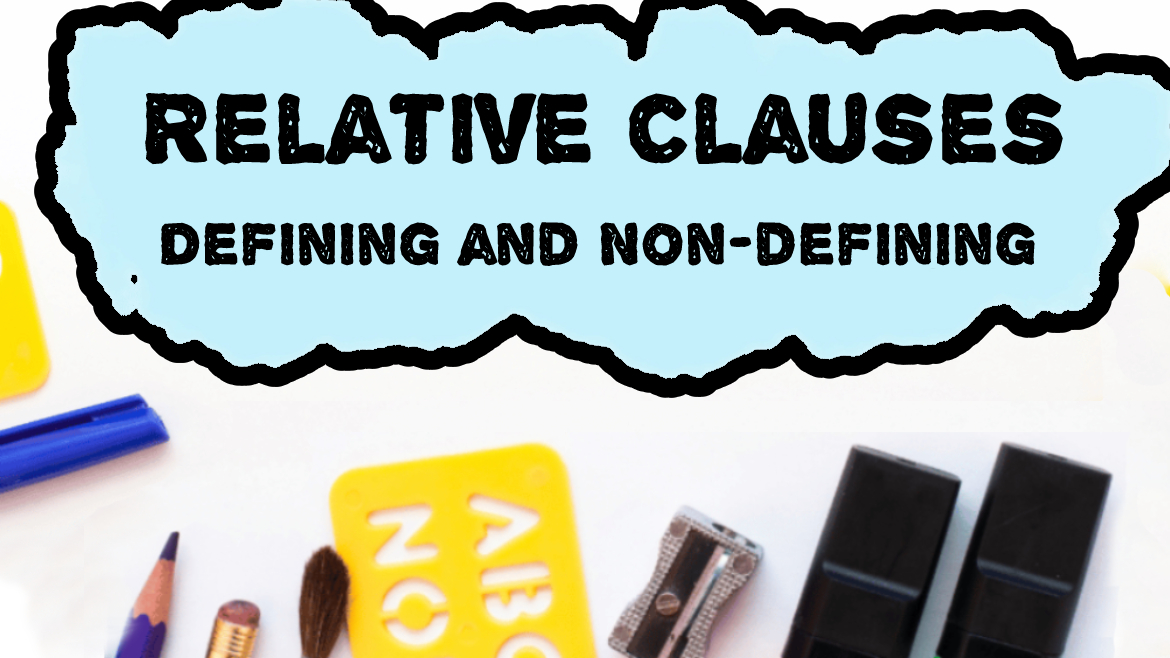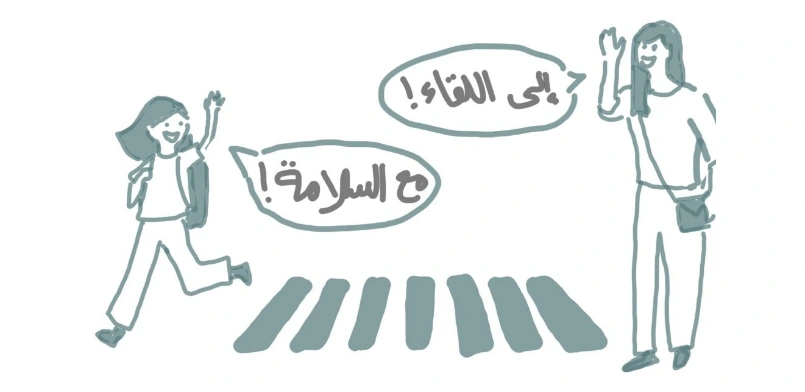عبارات یا جملات موصولی به دو نوع تقسیم می شوند. از این جملات برای ارائه اطلاعات در مورد کسی یا چیزی استفاده می کنیم – اطلاعاتی که برای درک اینکه به چه چیزی یا چه کسی ارجاع می شود نیاز است و آن چیز یا شخص را توضیح می دهد. جملات Defining برای ارائه اطلاعات ضروری و جملات Non-defining برای بیان اطلاعات غیرضروری استفاده می شوند که جملات نوع دوم قابل حذف شدن هستند و با حذف آن ها از جمله، مفهوم جمله موجود از بین نخواهد رفت.
ما معمولا از یک ضمیر موصولی Relative Pronoun مانند:
Who, that, where, which, whose, whom
برای تعریف یک جمله Relative Clause استفاده می کنیم. به مثال های زیر توجه کنید. جملات برجسته جملات Defining هستند و عباراتی که زیر آن ها خط کشیده شده، عباراتی هستند که این جملات به آن ها اشاره دارند.
They’re the people who want to buy our house.
آنها افرادی هستند که می خواهند خانه ما را بخرند.
Here are some cells which have been affected.
در اینجا چند سلولی که تحت تأثیر قرار گرفته اند آورده شده است.
They should give the money to somebody who they think needs the treatment most.
آنها باید پول را به کسی بدهند که فکر می کنند بیشتر به درمان نیاز دارد.
She’s now playing a woman whose son was killed in the First World War.
او اکنون در نقش زنی است که پسرش در جنگ جهانی اول کشته شده است.
تفاوت جملات defining و non-defining
جملات defining برای بیان اطلاعات ضروری بکار برده می شوند و وجودشان در جملات ضروری است اما جملات non-defining حاوی اطلاعات غیرضروری هستند و امکان حذف شان از جمله وجود دارد.
جملات non-defining بین دو کاما یا یک کاما و نقطه در صورتی که آخر جمله استفاده شوند قرار می گیرند که کاما اول قبل از ضمایر موصولی نوشته می شود و از این حالت می توان این جملات را تشخیص داد.
برای بیان جملات defining نیازی به نوشت کاما نخواهید داشت.
It’s a self-help book which teaches you how to relax. (defining)
This painting, which was painted in 1860, is worth millions of dollars. (non-defining)
Last week I visited my aunt, who’s nearly 90 years old.
ضمایر موصولی Relative Pronouns
برای تعریف جملات relative clause از ضمایر موصولی استفاده می کنیم. از جمله رایج ترین ضمایر موصولی می توان به who، whom، whose، which، that، where اشاره کرد. ضمایر موصولی را براساس نوع اسمی که می خواهیم به آن اشاره کنیم استفاده می شوند.
ضمیر موصولی Who
از who در relative clause برای اشاره به اشخاص و در برخی از مواقع حیوانات خانگی استفاده می کنیم. این ضمیر در جملات defining و non-defining استفاده می شود.
I think there’d be a lot of children who would love to have a climbing wall in school. (defining)
There’s this guy at work, who’s one of my friends, well he’s never been on a train. (non-defining)
حالت فاعلی و مفعولی
Who می تواند نقش فاعل یا مفعول را در جملات relative داشته باشد:
She’s going out with a bloke who’s in the army.
در این جمله who به a bloke اشاره دارد و فاعل is است.
The woman who I saw yesterday was Sheila.
در این جمله who اشاره به the woman دارد و مفعول saw است در این relative clause.
Who + prepositions
می توانیم از who به عنوان حرف تعریف یک حرف اضافه preposition استفاده کنیم:
It was Cath who Ian gave the keys to. It wasn’t me.
کلمه who به Cath اشاره دارد و یک حرف تعریف برای حرف اضافه to است.
ما حروف اضافه را در آخر جملات relative clause بیان می کنیم و نه بعد از کلمه who.
معمولا برای اسم های گروهی اشخاص از who استفاده می کنیم مثل، committee، government، group، panel، police، team.
Nicola phoned the fire brigade, who then alerted the police and social workers.
ضمیر موصولی Whom
از whom در فرم غیررسمی و یا نوشتار برای اشاره به اشخاص زمانی که فرد مفعول یک فعل است استفاده می شود. whom بیشتر در حالت نوشتاری استفاده می شود.
The response of those managers whom I have consulted has been very positive and we are looking forward to meeting together.
در اینجا whom اشاره دارد به those managers و مفعول فعل consulted در این جمله relative است.
She was a celebrated actress whom he had known and loved, on and off, almost since her first appearance on the stage.
Who + prepositions
رایج ترین کاربرد whom به همراه حرف اضافه است. می توانیم از whom به عنوان حرف تعریف یک حرف اضافه استفاده کنیم:
The first book was a terrible historical novel for children which was turned down by every publisher to whom it was sent.
Whom به every publisher اشاره دارد و حرف تعریف، حرف اضافه to است.
Drama in schools is particularly for pupils for whom English is a second language.
حرف اضافه را قبل از whom بکار می بریم.
ضمیر موصولی Whose
معمولا از whose به عنوان ضمیر موصولی برای بیان مالکیت افراد و حیوانات استفاده می شود. در حالت رسمی تر برای اشیا نیز استفاده می شود.
از whose قبل از اسامی به جای صفت های ملکی در جملات defining و non-defining استفاده می شود.
He’s marrying a girl whose family don’t seem to like him.
There was me and there was Kate, whose party it was, and then there were two other people.
It is a rambling Tudor house, whose sitting room looks out over a wonderful walled garden.
Whose + prepositions
می توانیم از whose + noun به عنوان حرف تعریف یک حرف اضافه استفاده کنیم:
Kate, whose sister I used to share a house with, has gone to work in Australia.
ما می توانیم حرف اضافه را بعد از ضمیر موصولی در نوشته های رسمی و یا در پایان relative clause در حالت غیررسمی تر بکار ببریم.
Thomas Goldney III, in whose house and garden several generations of Bristol students have now lived, was described in the late 18th century as ‘a very curious gentleman’. (more formal)
Thomas Goldney III, whose house and garden several generations of Bristol students have now lived in, was described in the late 18th century as ‘a very curious gentleman’. (more informal)
ضمیر موصولی Which
از which در جملات relative clause برای اشاره به حیوانات و اشیا استفاده می شود. از این ضمیر در هر دو حالت defining و non-defining استفاده می کنیم. ما همیشه از which برای بیان relative clauses وقتی که به کل جملات و عبارت اشاره دارد استفاده خواهیم کرد.
You need to tick the box which says yes.
He won’t have much time to prepare for the meeting, which is this afternoon.
She had to get up and walk all the way to the other side of the room, which isn’t easy with a bad back.
در اینجا which به کل جمله قبل از خودش اشاره دارد.
حالت فاعلی و مفعولی
Which می تواند نقش فاعل یا مفعول در relative clause داشته باشد:
The new sports complex, which will be built on the site of the old power station, will provide facilities for cricket, soccer, bowls and badminton.
در اینجا which به the new sports complex اشاره دارد و فاعل will be built است.
It was the same picture which I saw at the National Gallery.
در این جمله which به the same picture اشاره دارد و مفعول saw است.
Which + prepositions
می توانیم از which به عنوان حرف تعریف، حروف اضافه استفاده کنیم.
Early in the Autumn Term there is a reception at which you can meet current staff and students.
Which به a reception اشاره دارد و حرف تعریف at است.
می توانیم حرف اضافه را قبل از ضمیر موصولی در حالت رسمی تر و یا در آخر جمله relative clause در حالت غیررسمی تر بکار ببریم.
The title of the poem indicates that the poet knows himself to be separated from the community in which he grew up. (more formal)
I’ve never felt close to the community which I grew up in. (more informal)
ضمیر موصولی That
ما از that به جای who، whom و which در جملات relative clause برای اشاره به افراد، حیوانات و اشیا استفاده می کنیم. از that فقط در جملات defining استفاده می کنیم. کلمه that غیررسمی تر از who، whom و which می باشد.
We met somebody last night that did the speech therapy course two years after you.
The 8.30 is the train that you need to get.
She blamed herself for everything that had happened.
حالت فاعلی و مفعولی
that می تواند به عنوان فاعل یا مفعول جملات relative clause بکار برده شود.
He finally remembers one lesson that his mum had taught him early – Don’t take that doesn’t belong to you.
That به money اشاره دارد و فاعل belong است.
It’s the same cooker that my mother has.
That به the same cooker اشاره دارد و مفعول has است.
That بعد از صفات عالی
معمولا بعد از that از صفات عالی استفاده می شود.
The Wimbledon men’s final was the best game of tennis that I’ve ever seen.
That + prepositions
That می تواند اشاره به حرف تعریف، حرف اضافه داشته باشد.
We’ve got some tennis balls that you can play with.
That اشاره دارد به some tennis balls و حرف تعریف with است.
برخلاف which، whom و whose نمی توانید قبل از that از حروف اضافه استفاده کنید.
فرق who و which
در جملات relative clause همانطور که در بالا به صورت کامل اشاره شد از which برای اشاره به اشیا و حیوانات استفاده می شود و برای اشاره کردن به افراد سراغ who می رویم.
هر دو این ضمایر موصولی در دو حالت defining و non-defining بکار برده می شوند. به مثال های زیر توجه کنید:
Harper Lee is the woman who wrote To Kill a Mockingbird.
هارپر لی کسی هست که کتاب کشتن مرغ مقلد رو نوشته.
Last week I visited my aunt Jane, who is nearly 90 years old.
هفته پیش عمه ام جین رو دیدم که نزدیک ۹۰ سال سن داره.
I’m looking for a book which teaches you how to relax.
دنبال کتابی می گردم که یاد میده چطور ریلکس کنیم.
This painting, which was painted in 1860, is worth millions of dollars.
این نقاشی که در سال ۱۸۶۰ کشیده شده میلیون ها دلار میارزه.
ضمایر موصولی When، Where و Why
در حالت غیررسمی معمولا از where، when و why برای بیان جملات defining relative clause به جای at which، on which یا for which استفاده می شود.
از where برای مکان ها استفاده می شود:
I know a restaurant where the food is excellent.
( … a restaurant at which the food is excellent.)
از when برای زمان استفاده می شود:
There isn’t a day when I don’t feel rushed off my feet.
( … a day on which I don’t feel rushed … )
و از why برای بیان دلایل استفاده می شود:
Do you know the reason why the shop is closed today?
( … the reason for which the shop is closed … )
استفاده نکردن از ضمایر موصولی
در حالت غیررسمی ما معمولا ضمیر موصولی را می توانیم حذف کنیم. اینکار را فقط می توانیم در defining relative clauses انجام دهیم و زمانی که ضمیر موصولی مفعول، فعل می باشد. زمانی که ضمیر موصولی فاعل، فعل باشد نمی توانیم ضمیر موصولی را حذف نماییم و همچنین اینکار در جملات non-defining clauses نیز قابل انجام نخواهد بود.
German is a language which I’ve found hard to learn.
(or German is a language I’ve found hard to learn.)
She’s the singer who I heard on the radio.
(or she’s the singer I heard on the radio.)
There’s a hill which begins three miles after the start of the race.
در این جمله which فاعل می باشد و قابل حذف نیست.
Sir James, whose birthday is on February 26, plans to lay on a big party.
در این جمله نیز به دلیل اینکه جمله non-defining می باشد ضمیر موصولی قابل حذف نیست.
در defining clauses می توانیم ضمیر موصولی را حذف کنیم زمانی که حرف تعریف، حروف اضافه است. وقتی اینکار را می کنیم همیشه حرف اضافه را در آخر relative clause قرار می دهیم.
She was at the garden party which I was telling you about.
(or she was at the garden party about which I was telling you. or She was at the garden party I was telling you about.)
حتما بخوانید:






